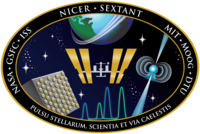
Back Neutron Star Interior Composition Explorer German Neutron Star Interior Composition Explorer French NICER HE Penjelajah Komposisi Interior Bintang Neutron ID Neutron Star Interior Composition Explorer Italian NICER Japanese NICER Dutch Neutron Star Interior Composition Explorer Portuguese Найсер (компонент МКС) Russian NICER (космічний телескоп) Ukrainian
 NICER telescope mounted on the Integrated Truss Structure of the International Space Station | |
| Mission type | Neutron star astrophysics |
|---|---|
| Operator | NASA / GSFC / MIT |
| Website | https://heasarc.gsfc.nasa.gov/docs/nicer/ |
| Mission duration | 18 months (planned) 6 years, 11 months and 26 days (in progress) |
| Spacecraft properties | |
| Launch mass | 372 kg (820 lb) [1] |
| Start of mission | |
| Launch date | 3 June 2017, 21:07:38 UTC[2] |
| Rocket | Falcon 9 Full Thrust, B1035.1 |
| Launch site | Kennedy Space Center, LC-39A |
| Contractor | SpaceX |
| Orbital parameters | |
| Reference system | Geocentric orbit |
| Regime | Low Earth orbit |
| Perigee altitude | 402 km (250 mi) |
| Apogee altitude | 407 km (253 mi) |
| Inclination | 51.64° |
| Period | 92.66 minutes |
| Instruments | |
| X-ray Timing Instrument (XTI) | |
 NICER * SEXTANT mission patch Explorer program | |
The Neutron Star Interior Composition ExploreR (NICER) is a NASA telescope on the International Space Station, designed and dedicated to the study of the extraordinary gravitational, electromagnetic, and nuclear physics environments embodied by neutron stars, exploring the exotic states of matter where density and pressure are higher than in atomic nuclei. As part of NASA's Explorer program, NICER enabled rotation-resolved spectroscopy of the thermal and non-thermal emissions of neutron stars in the soft X-ray (0.2–12 keV) band with unprecedented sensitivity, probing interior structure, the origins of dynamic phenomena, and the mechanisms that underlie the most powerful cosmic particle accelerators known.[3] NICER achieved these goals by deploying, following the launch, and activation of X-ray timing and spectroscopy instruments. NICER was selected by NASA to proceed to formulation phase in April 2013.[4]
NICER-SEXTANT uses the same instrument to test X-ray timing for positioning and navigation,[5] and MXS is a test of X-ray timing communication.[6] In January 2018, X-ray navigation was demonstrated using NICER on ISS.[7]
- ^ "SpaceX CRS-11 Mission Overview" (PDF). NASA. Retrieved 3 June 2017.
 This article incorporates text from this source, which is in the public domain.
This article incorporates text from this source, which is in the public domain.
- ^ Clark, Stephen (3 June 2017). "Reused Dragon cargo capsule launched on journey to space station". Spaceflight Now. Retrieved 3 June 2017.
- ^ Gendreau, Keith C.; Arzoumanian, Zaven; Okajima, Takashi (September 2012). Takahashi, Tadayuki; Murray, Stephen S.; Den Herder, Jan-Willem A. (eds.). "The Neutron star Interior Composition ExploreR (NICER): an Explorer mission of opportunity for soft X-ray timing spectroscopy" (PDF). Proceedings of the SPIE: Space Telescopes and Instrumentation 2012, Ultraviolet to Gamma Ray. Space Telescopes and Instrumentation 2012: Ultraviolet to Gamma Ray. 8443: 844313. Bibcode:2012SPIE.8443E..13G. doi:10.1117/12.926396. S2CID 119892783.
- ^ Harrington, J. D. (5 April 2013). "NASA Selects Explorer Investigations for Formulation" (Press release). NASA. Retrieved 23 April 2013.
- ^ Garner, Rob (17 July 2017). "NASA Neutron Star Mission Begins Science Operations". NASA. Retrieved 26 January 2018.
- ^ Cite error: The named reference
nasa20161104was invoked but never defined (see the help page). - ^ "ISS Utilization: NICER/SEXTANT". eoPortal. European Space Agency. Archived from the original on 8 February 2021. Retrieved 26 January 2018.
© MMXXIII Rich X Search. We shall prevail. All rights reserved. Rich X Search